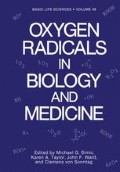Abstract
Bryostatins are macrocyclic lactones derived from the marine bryozoan Bugula neritina and are currently being investigated for their apparent anti-neoplastic activities.1,2 In addition, certain bryostatins have been shown to share certain properties with the tumor promoting compound 12-O-tetradecanoylphorbol 13-acetate (TPA). These properties include the activation of human neutrophils to generate superoxide anion and the release of specific granules3. In vitro, certain bryostatins also appear to bind and activate the TPA receptor protein kinase-C (PK-C), a process which results in the phosphorylation of nearly identical protein substrates phosphorylated by TPA3.
Access this chapter
Tax calculation will be finalised at checkout
Purchases are for personal use only
Preview
Unable to display preview. Download preview PDF.
References
G.R. Pettit, C.L. Hearld, Y. Kamano, D. Gust and R. Aoyagi, The structure of Bryostatin 2 from the marine bryoszoan Bugula neritina. J. Nat. Prod. 46:528 (1983.
G.R. Pettit, C.L. Herald and Y. Kamano, The structure of the Bugula neritina (marine, bryozoa) antineoplastic component Bryostatin 3, J. Org. Chem. 48:5354 (1983).
R.L. Berkow and A.S. Kraft, Bryostatin, a non-phorbol macrocyclic lactone, activates intact human polymorphonuclear leukocytes and binds to the phorbol ester receptor, Biochem. Biophys. Res. Comm. 131:1109 (1985).
D. Roos, A.A.M. Bot, M.L.J. van Schaik, M. de Boer and M.R. Daha, Interaction between human neutrophils and zymosan particles: the role of opsonins and divalent cations, J. Immunol. 126:433 (1981).
K. Cheung, A.C. Archibald and M.F. Robinson, The origin of chemilum-minescence produced by neutrophils stimulated by opsonized zymosan, J. Immunol. 130:2324 (1983).
Author information
Authors and Affiliations
Editor information
Editors and Affiliations
Rights and permissions
Copyright information
© 1988 Plenum Press, New York
About this chapter
Cite this chapter
Warren, J.T., Esa, A.H., Pettit, G.R., May, W.S. (1988). Bryostatin Stimulation of Human Neutrophil Luminol and DBA (Lucigenin) Chemiluminescence. In: Simic, M.G., Taylor, K.A., Ward, J.F., von Sonntag, C. (eds) Oxygen Radicals in Biology and Medicine. Basic Life Sciences, vol 49. Springer, Boston, MA. https://doi.org/10.1007/978-1-4684-5568-7_34
Download citation
DOI: https://doi.org/10.1007/978-1-4684-5568-7_34
Publisher Name: Springer, Boston, MA
Print ISBN: 978-1-4684-5570-0
Online ISBN: 978-1-4684-5568-7
eBook Packages: Springer Book Archive

